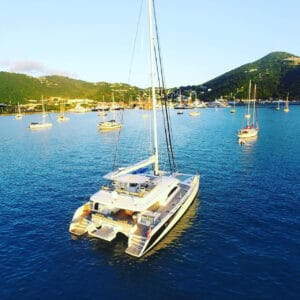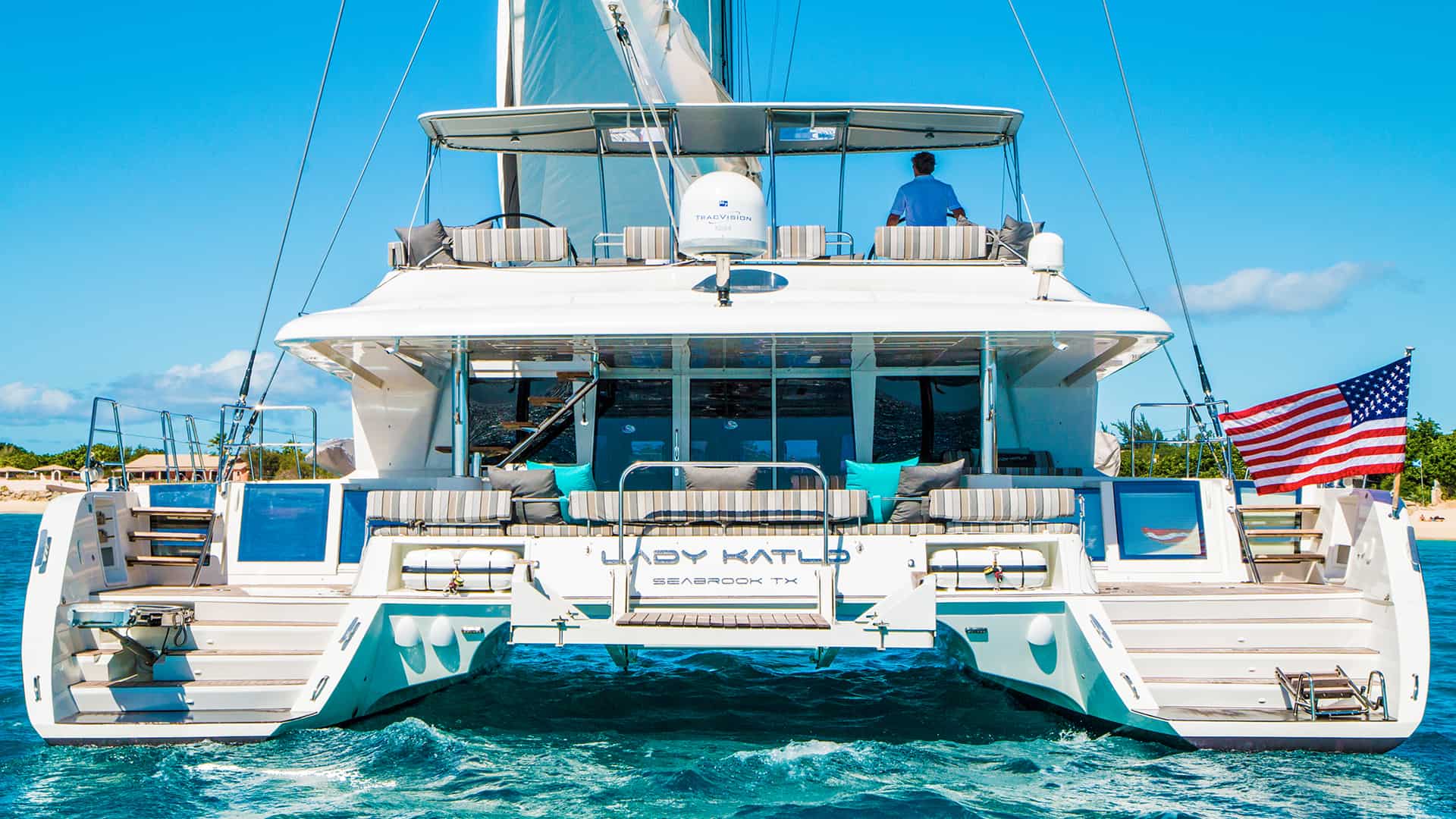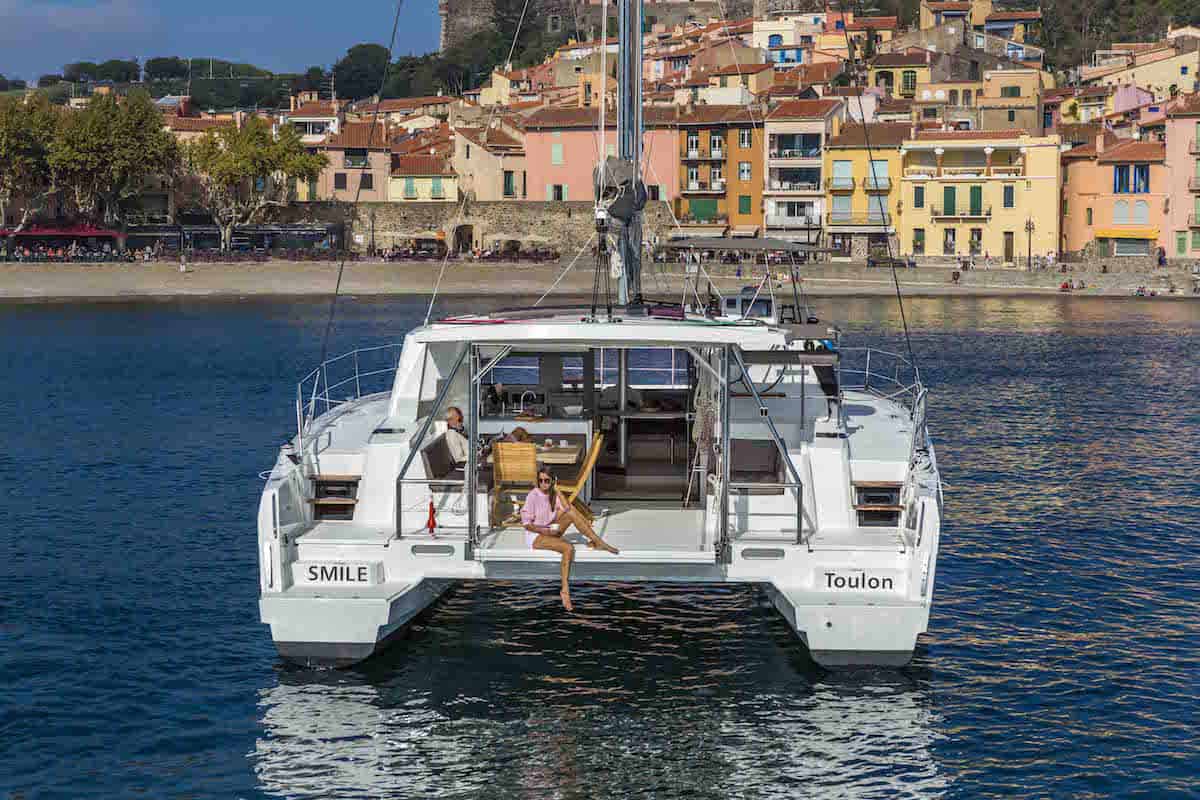Reducing Costs of Yacht Ownership – Our Experience
 In the early days, Stephen and I worked as we sailed the world to offset yacht costs and well as to fund our necessary living expenses. One of the first ideas was to generate income. We offered SCUBA diving charter excursions in the Indian Ocean on our monohull “Royal Salute“. These excursions were successful because we could take divers to remote places reachable only by boat like Pemba Island or Zanzibar. Later, we taught week-long live-aboard sailing schools in the Caribbean and Bahamas on our catamaran “Siyaya”.
In the early days, Stephen and I worked as we sailed the world to offset yacht costs and well as to fund our necessary living expenses. One of the first ideas was to generate income. We offered SCUBA diving charter excursions in the Indian Ocean on our monohull “Royal Salute“. These excursions were successful because we could take divers to remote places reachable only by boat like Pemba Island or Zanzibar. Later, we taught week-long live-aboard sailing schools in the Caribbean and Bahamas on our catamaran “Siyaya”.
We also offered fully-catered, crewed charters in different parts of the world like Tanzania, Kenya, and Turkey. These experiences were not only a great way to fill up the cruising kitty, but were also life-enriching experiences.
We have also managed yacht charters, worked with catamaran manufacturers, and even were part owners in a catamaran manufacturer at one time. Through our adventures and jobs, we met hundreds of people from all walks of life and more than twenty years later, we are still in contact with most of them.
One such person we met along the way is our good friend, Michel Benarrosh, the former commodore for The Moorings Owner’s Group and owner of Sailonline.com. He has owned three sailing yachts (45ft to 50ft) in charter management fleets in the BVI:
- a bareboat in charter management
- a boat in a crewed charter fleet
- a charter yacht owned outright with partners.
He has seen all sides of the coin when it comes to yacht ownership. His experiences have led him to regularly recommend placing boats in a charter program as a way to offset costs of yacht ownership. He says, “I got to enjoy a great activity with my son while teaching him about seamanship, marine science, and love and respect of the environment. I made a lot of great new friends. I owned a boat partly paid for by charter income after 5 years of personal enjoyment. I can’t think of anything I could have spent my money on that would have given me so much enjoyment and fulfillment over the years…”
We have practiced these techniques and helped many of our brokerage clients do the same. Offsetting the costs of catamarans with charter income and tax advantages makes sense for most catamaran buyers. Whether you plan to charter your catamaran and go cruising after a few years or want to own a yacht and need someone to manage it in your absence, it makes sense to make your asset pay for at least some of its carrying costs.
But don’t be fooled! You can get trapped into something that does not work for you because not all management companies or charter operations are good fits for everyone. Not every boat fits the “charter” model either. Make sure that you understand what you are getting into. Read and understand your contract. Make sure you have a good exit strategy and if you are unsure, get a good expert advisor.
So, you can tell that there are many ways to reduce costs of ownership. While all aspects are not for everyone, we share these 10 tips from which you can choose the advice that fits your lifestyle and budget constraints.
Ten Tried & True Ways To Reduce Yacht Ownership Costs
1) Yacht Charter Management
Yacht ownership through a management program in a charter company enables you to offset up to 50% of the purchase price. You will, however, need to put about 10% of the original purchase price back into the boat to get it ready to go cruising after phase-out from the charter company. You will need to replace wear-and-tear items like new sails, new instruments, install a watermaker (although some charter boats now have them anyway), and do cosmetic refurbishments. The charter industry has matured over the last 30 years to the stage where it is no longer a given that the boat will be “trashed” at the end of the 5-year term as once was the case. So, you can walk away after the 5-year charter term with a pretty good boat only needing some upgrades and cosmetic fixes with it halfway paid off.
Visit our section on yacht charter management for more information.
2) Yacht-As-A-Business
In our experience, yacht charter management together with active participation by the owner is a great way to reduce the cost of yacht ownership. We found that most yacht owners use this program as an avenue to acquire a cruising yacht for retirement at a big discount. With this business model, you place your boat into a corporation and into a charter company and run it as a small business to take advantage of tax breaks, government programs, and income from charter. If you are a US taxpayer, this is probably the best route to go as it yields the best return in a controlled environment. Although the acquisition of a new yacht may be an effective business tool to take advantage of these tax rules, the tax benefits must be carefully planned, documented and implemented to make sure that it can withstand scrutiny.
Check out our section on the Yacht as a Business program for more details.
3) Sailing School Program
 Using an educational or sail training program such as a live-aboard sailing school with a sailing instructor on board, is another great way to offset the cost of ownership. The boat will be under the care of a skipper and will usually hold up much better than just a regular bareboat charter boat. It will generate good income, covering its holding costs and possibly the mortgage payments as well. We have personally used this ownership model and have helped set up several clients to operate a sailing school very successfully in the Bahamas, Fort Lauderdale, and the BVI like this Prout 45, the namesake in Kanina Sailing Adventures. This takes commitment and time but can it be very profitable. Deon & Janine of Kanina Sailing Adventures say: “Stephen and Estelle helped us set up our Sea School Business in the Bahamas Active Yacht Ownership Program and tax advantages three years ago and it is still going strong…it worked exactly like they told us it would!”
Using an educational or sail training program such as a live-aboard sailing school with a sailing instructor on board, is another great way to offset the cost of ownership. The boat will be under the care of a skipper and will usually hold up much better than just a regular bareboat charter boat. It will generate good income, covering its holding costs and possibly the mortgage payments as well. We have personally used this ownership model and have helped set up several clients to operate a sailing school very successfully in the Bahamas, Fort Lauderdale, and the BVI like this Prout 45, the namesake in Kanina Sailing Adventures. This takes commitment and time but can it be very profitable. Deon & Janine of Kanina Sailing Adventures say: “Stephen and Estelle helped us set up our Sea School Business in the Bahamas Active Yacht Ownership Program and tax advantages three years ago and it is still going strong…it worked exactly like they told us it would!”
4) Continuing Education Yacht Program
Put your boat into an “Ongoing or Continuing Education” program whereby it can generate income and possibly tax advantages. This program works well for doctors, real estate professionals, lawyers, accountants, and other high-income professionals. You can use the boat as a platform / venue for the professional continuing education seminars and not only earn income, but write expenses off on your tax return since the boat is run as a business. You can operate the boat yourself or hire a crew. A good example would be Market America who owns several yachts that are used in their business for continuing education events for their associates. Another example is our client in Tampa, a medical doctor, who uses his Island Spirit catamaran as a training facility from the beautiful Tampa Yacht Club for other doctors to do their CME. There are all kinds of other examples for professionals like accountants, dentists, dermatologists etc. and in fact, The Moorings offers group charter events, combining medical education with a fun-filled vacation for medical professionals seeking CME credits. This is a very good way for a professional person to offset costs of yacht ownership.
5) Crewed Yacht Business
You can offset the cost of ownership of a bigger (50ft and up) catamaran by earning income through luxury charter and using available tax advantages. It is the most cost effective way to own a big luxury yacht! This might require a bit more personal involvement, unless you have a staff to take care of the business.
There are three ways to do this:
- The owners live aboard, are personally the crew, and operate their catamaran as a business like our clients from “Feel the Magic” in the BVI.
- Charter companies like Dream Yacht and The Moorings offer “by the cabin” charters on their bigger catamarans that enable guests to enjoy an all-inclusive luxury crewed charter for the price of a stateroom instead of the whole yacht. We have set up several of our clients in this program with boats such as the Lagoon 620, Fountaine Pajot Sanya 57, Lagoon 77, and Fountaine Pajot Ipanema 58.
A crewed yacht business generates very good income and can qualify for substantial tax advantages as well as business tax deductions.
Visit our section on Crewed Yacht Ownership.
6) Yacht Partnerships In A Charter Program
Buying a boat with a partner is becoming more popular in part because charter companies allow more generous “owner’s use” as an incentive for buyers. Therefore, two  families can each enjoy 3 to 4 cruising weeks per year, which is often more than most people can use annually. Another reason partnerships are desirable is that the financial burden is shared. You could go into a partnership with one or more people and negotiate a buy back at the end of the period. At the end of the program, you will own the boat and you finance only the depreciated value at the end of the term.
families can each enjoy 3 to 4 cruising weeks per year, which is often more than most people can use annually. Another reason partnerships are desirable is that the financial burden is shared. You could go into a partnership with one or more people and negotiate a buy back at the end of the period. At the end of the program, you will own the boat and you finance only the depreciated value at the end of the term.
Of course, there is risk to partnerships, so you will need a rock solid contract establishing the exact rules, responsibilities, and owners’ use between the partners. However, do not be intimated by this prospect. It is a simple document and an easy process. Sailonline.com provides a document tailor-made for partnerships. It covers most situations that can arise during the life of the partnership but can easily be adapted to your personal situation.
See our article on partnerships.
7) Yacht Cruise Club
Join a cruise club like Sailtime.com (they have about 150 boats worldwide), where you pay an entry fee as well as an annual fee that is the same or less than a charter fee for usage over a 5-year period and then end up with ownership of the yacht at the end.
8) French Tax Incentives For New Yachts
Buy into a charter company like Dream Yacht Charter or Navigare that offer French tax incentive boats. The cost of the boat can be as low as 45% of the full price of the boat once fully equipped and delivered to the charter base. One such program is the “Dream Easy Program” from Dream Yacht Charters. For example, you can own a luxury yacht like a Bali 45 catamaran with only 35% down and a balloon payment of 25% at the end of a 66-month term. There is no operational expense to the owner and worldwide reciprocal owners’ use is available.
There is also the “defiscalisation program” where you pay about 45% upfront, no expenses, no income with reciprocal owner use worldwide and at the end of the program you own the boat free and clear. The bigger Catana cats (55, 62, etc.) are favorites of our clients for this program. There are some snags to navigate, so make sure that you understand the contract and limitations of these programs.
9) Peer-to-Peer Yacht Rental
Yacht rental pool is one of the fastest growing programs in the world. It is a “peer-to-peer” boat rental program where a company like Boatbound, Sailo, Boatsetter, Getmyboa, Click&Boat, Samboat and Afloatbnb, take yachts into a rental pool and rent it out to pre-screened, qualified boat renters. The company collects the rental fee, provides charter insurance, and takes a share up front (up to 25%), and pays the owner the rest for the charter fee. You are in control of the price and approve the renters.
It is a good program if you do not want to be in a permanent charter fleet. However, it takes some involvement from the owner. You handle the approval of the booking, cleaning and prepping of the vessel, meeting and greeting, orientation of the yacht, and other day-to-day operational decisions. Our clients, Bob and Deb, have been doing this very successfully for a couple of years on the Chesapeake. They rent their yacht, a Prout 45 (Elizabeth Austin Yachts), out when convenient for them during the summer on the Chesapeake. This rental income covers their dockage and insurance.
10) Fractional Yacht Ownership
Fractional yacht ownership, is exactly what it sounds like—you buy a fraction of a yacht. It is not a time-share where you only purchase the rights of usage for a certain amount of time. At the end of the period, your “investment” also comes to an end. But, with fractional ownership you legally own the fraction of the asset, and can transfer or sell it. You pay an annual membership fee and have the use of the boat for a certain period of time every year shared with several owners. There are pluses and minuses for this type of ownership. Make sure you understand the rules!
With all these examples you find a way that works for you to substantially reduce the cost of yacht ownership. In some cases, this includes using business tax deductions. We caution everyone to do his or her due diligence, plan your exit strategy, and consult with experts in the field.
Interested In Reducing The Costs Of Yacht Ownership?
Contact Us For A Free Personal Consultation
The Catamaran Guru is a brand-independent yacht brokerage working with various charter management companies and yacht brands to bring our boat-buying clients the programs and boat models that are best for their situation and goals. Catamaran Guru is no longer affiliated with Dream Yacht (DYC).

